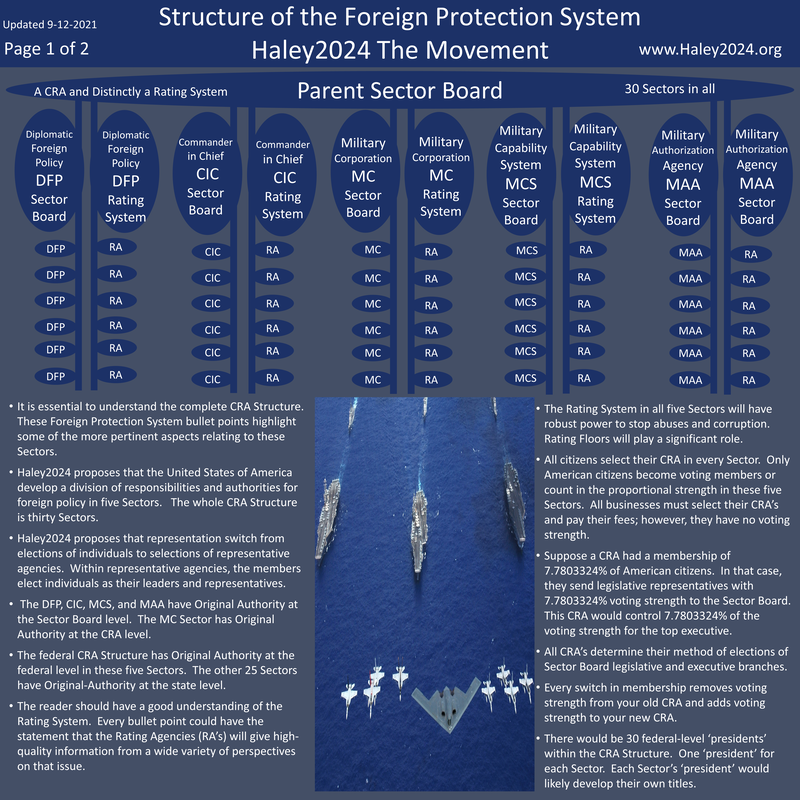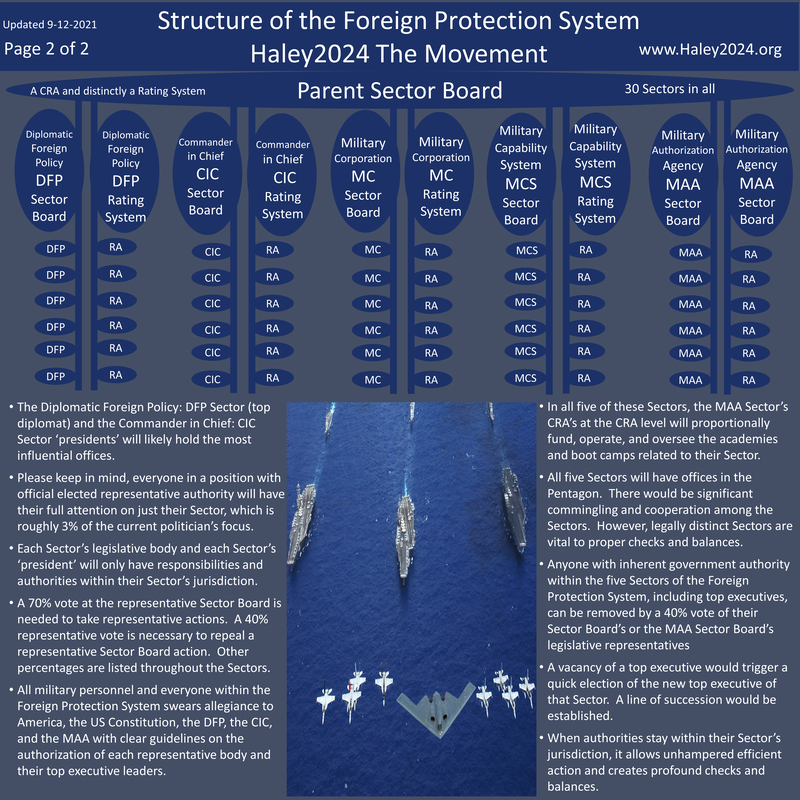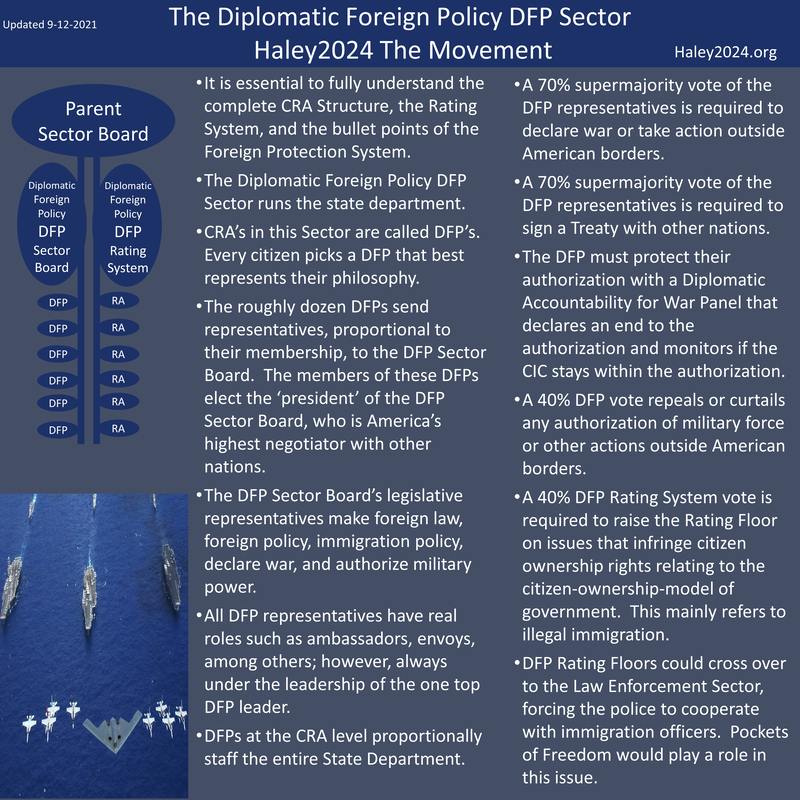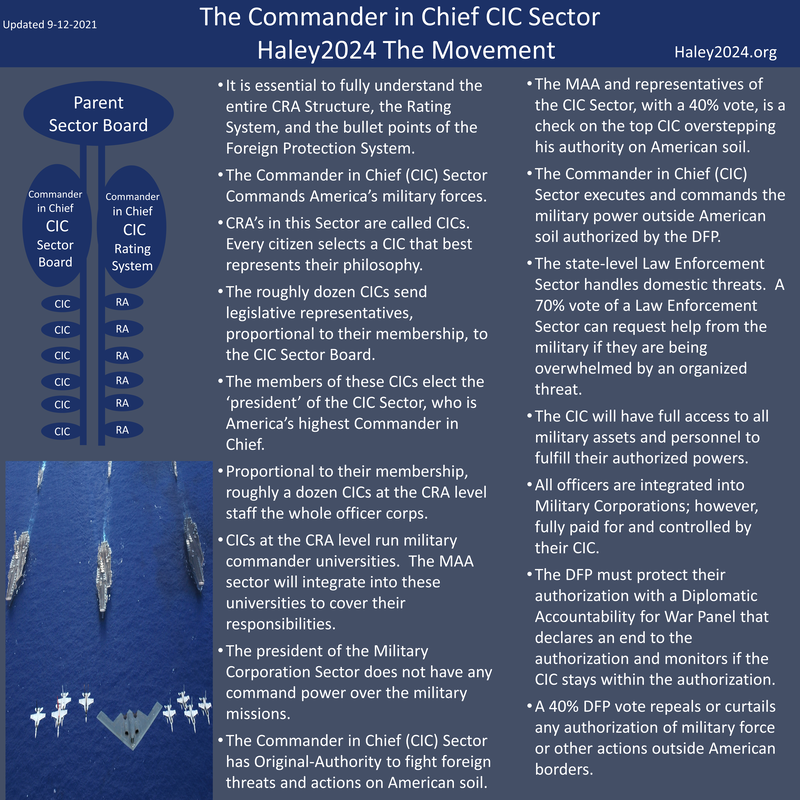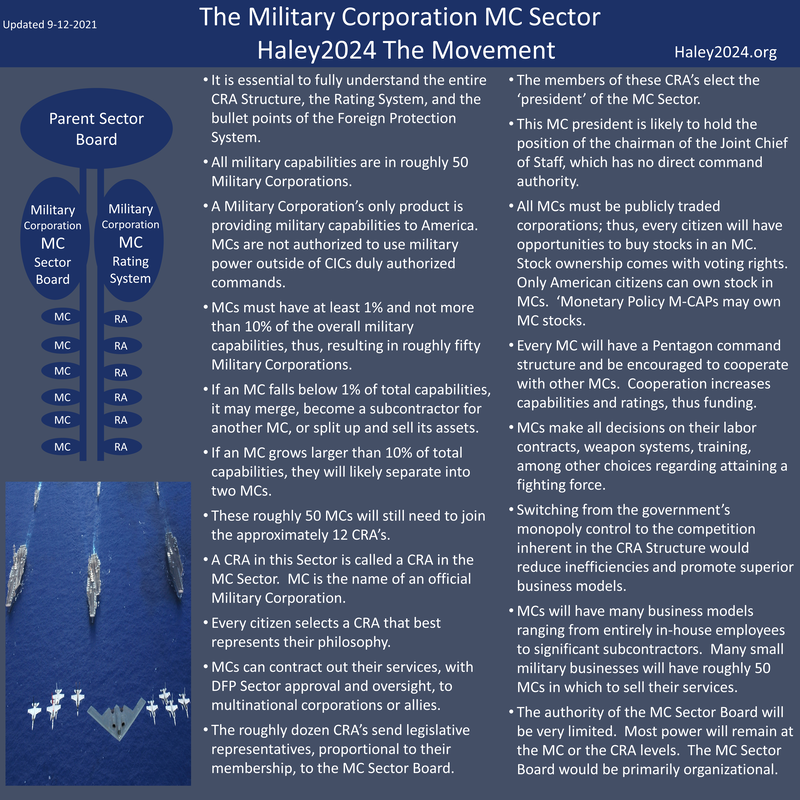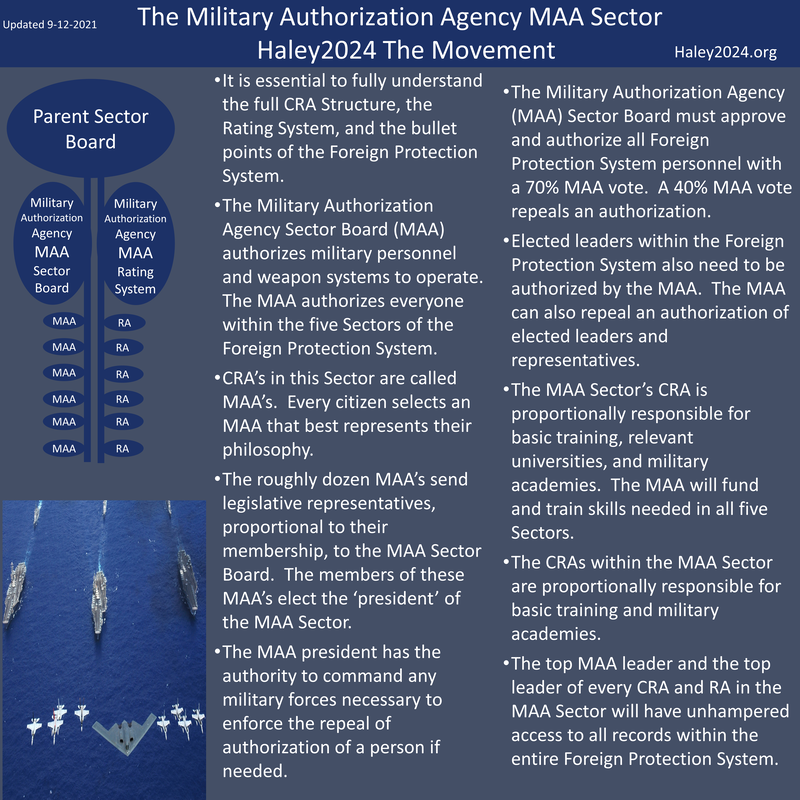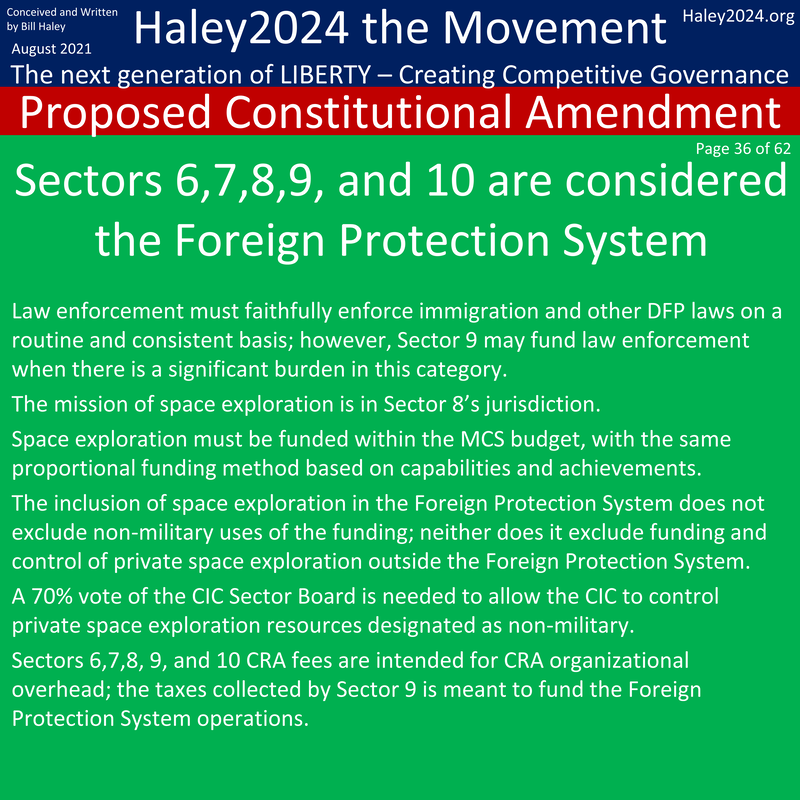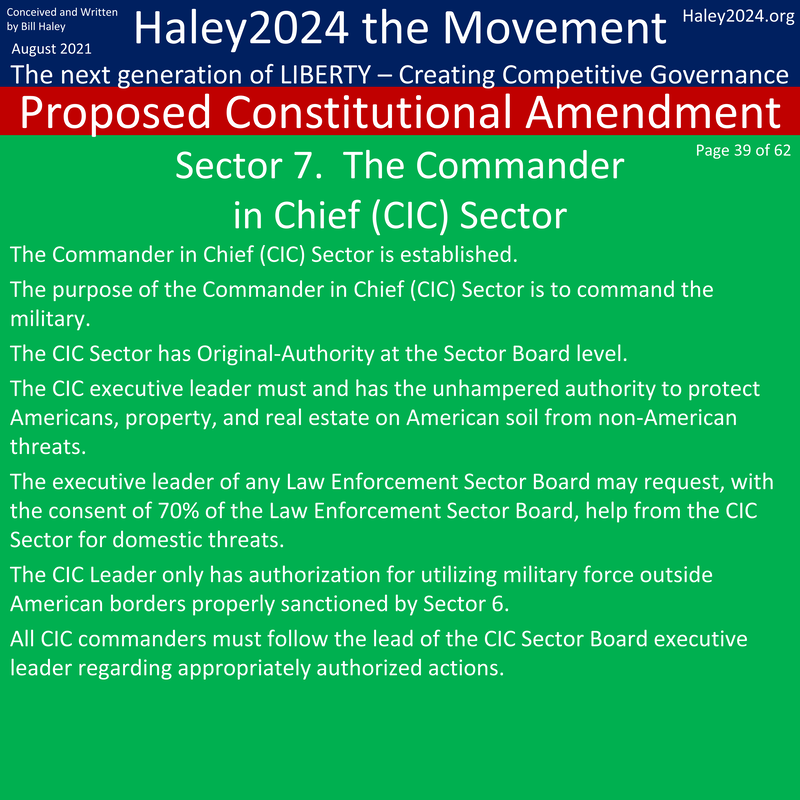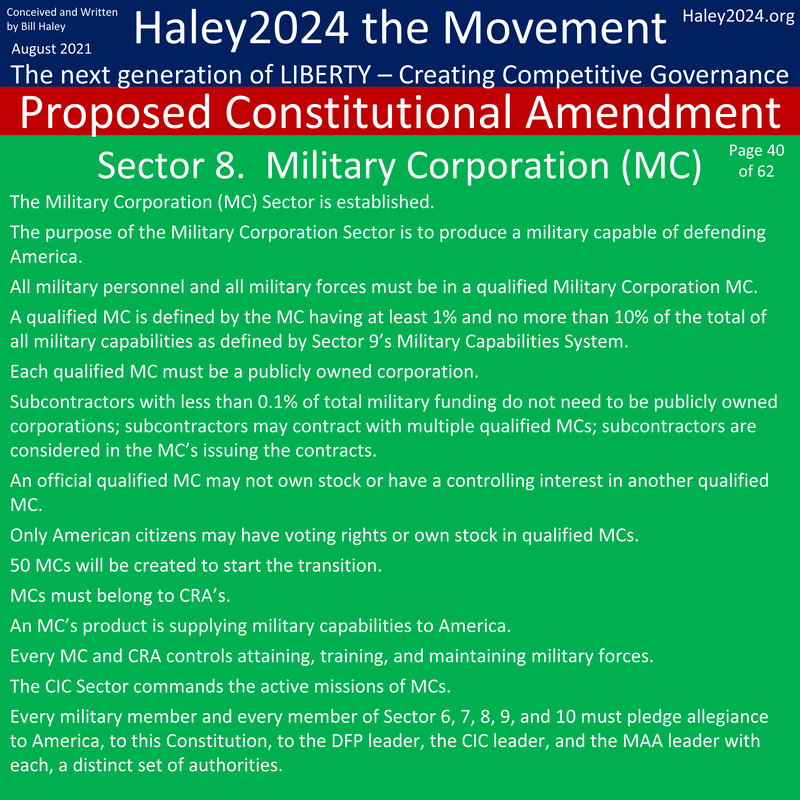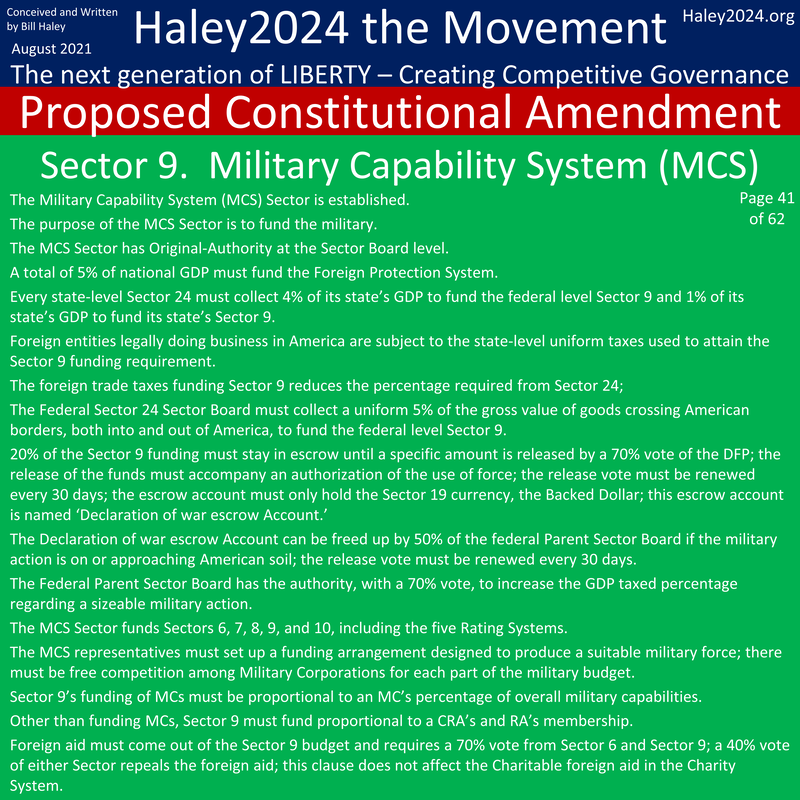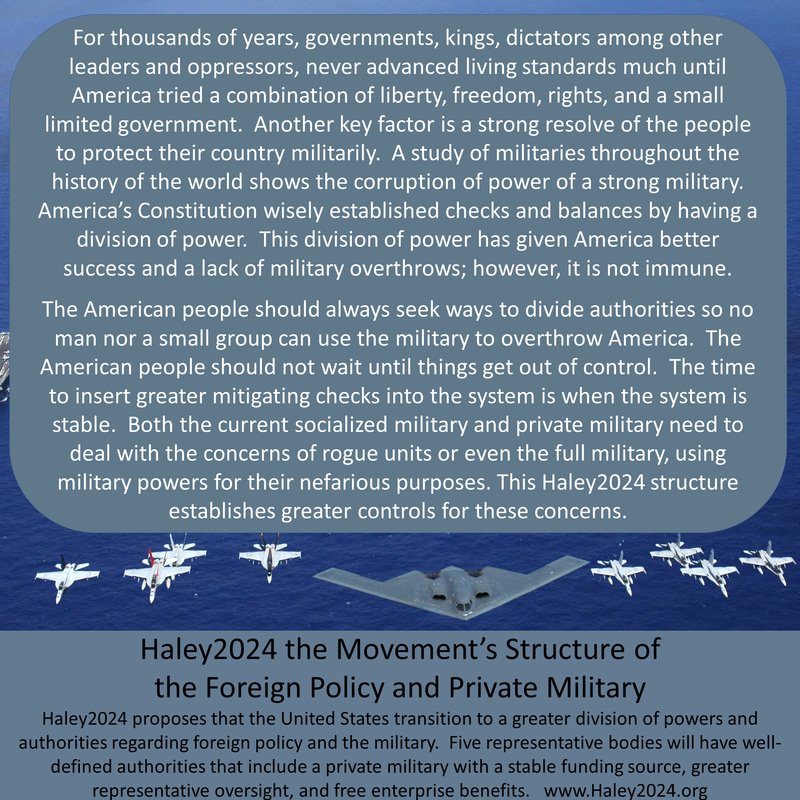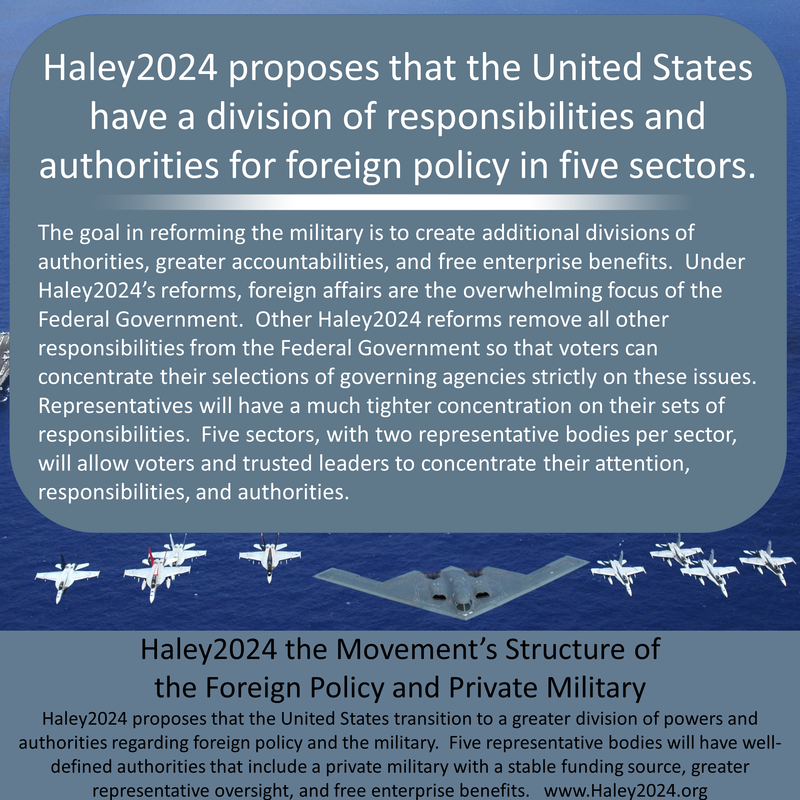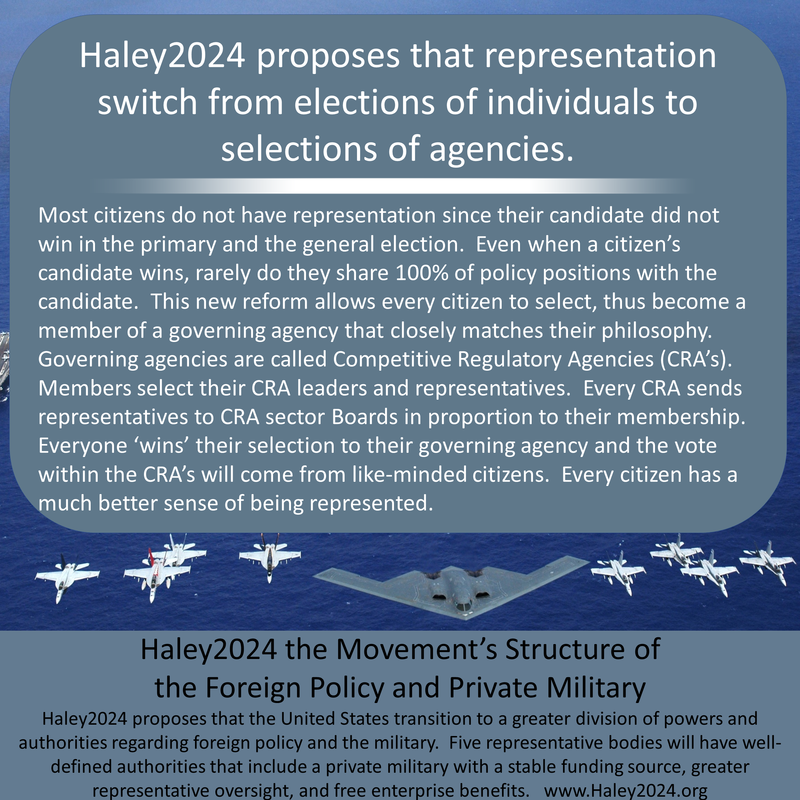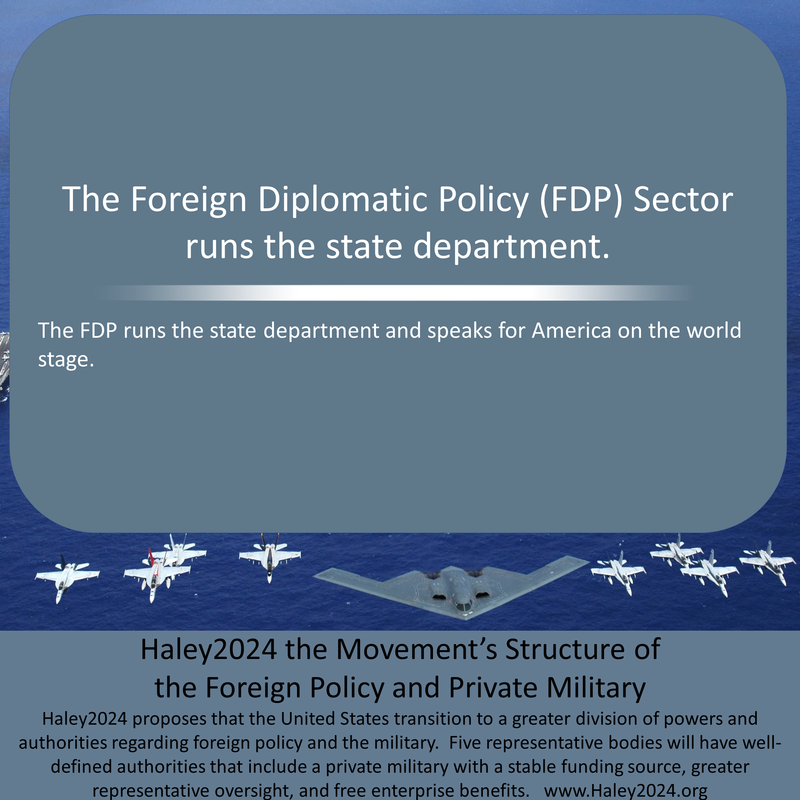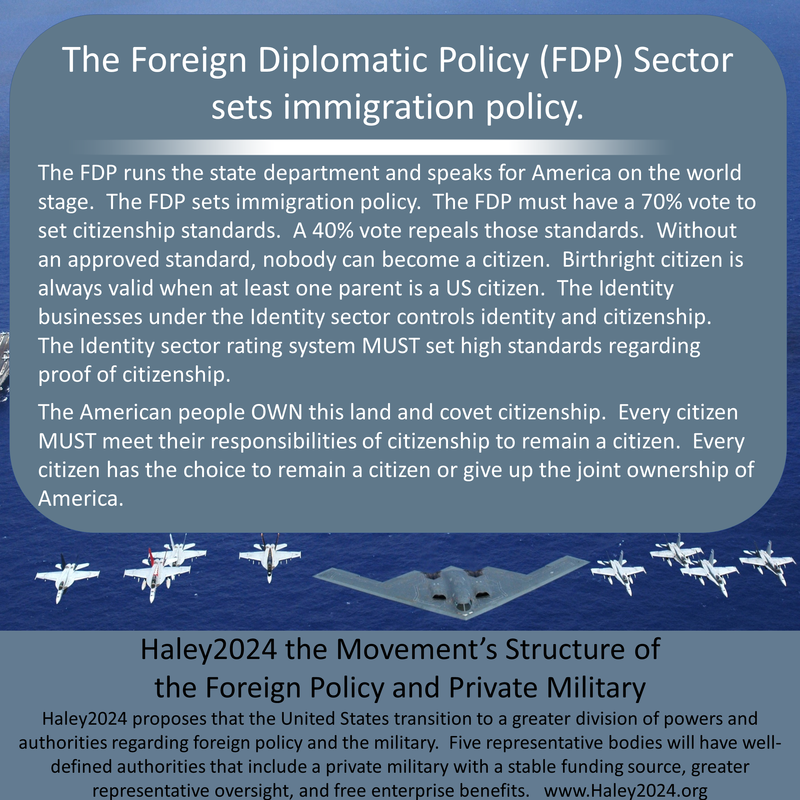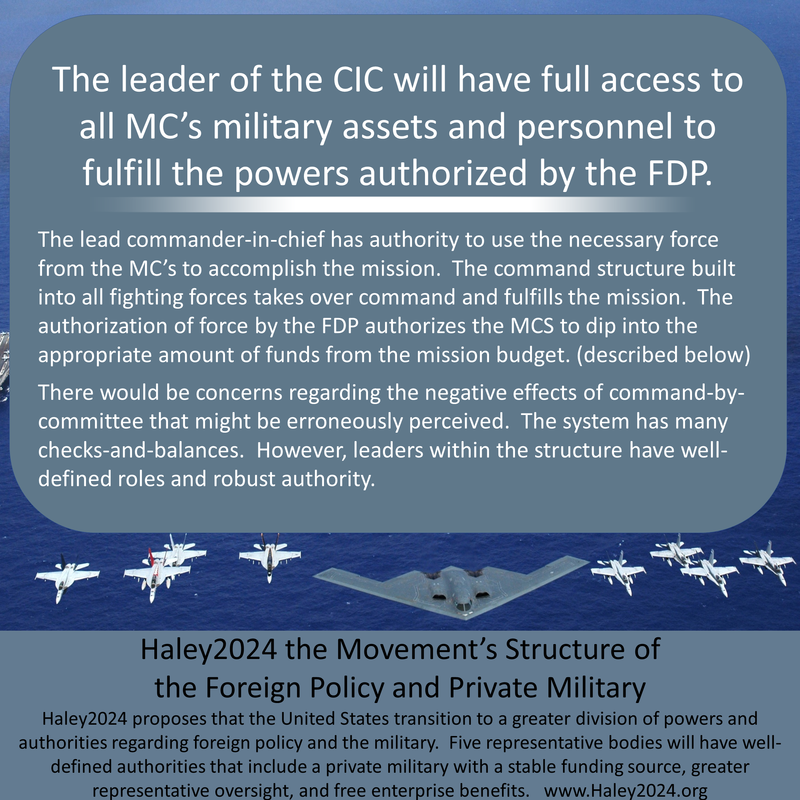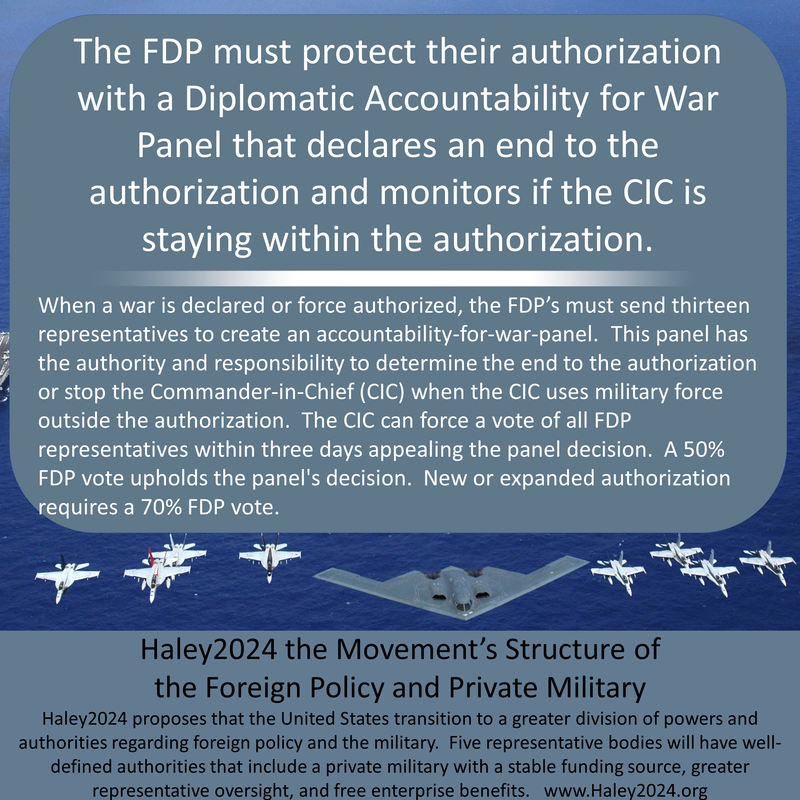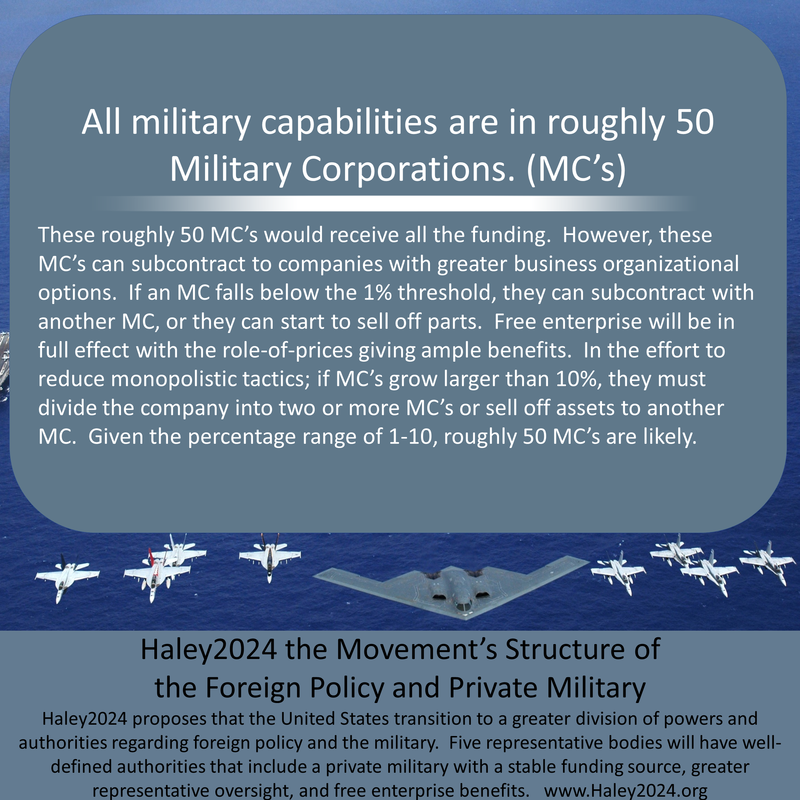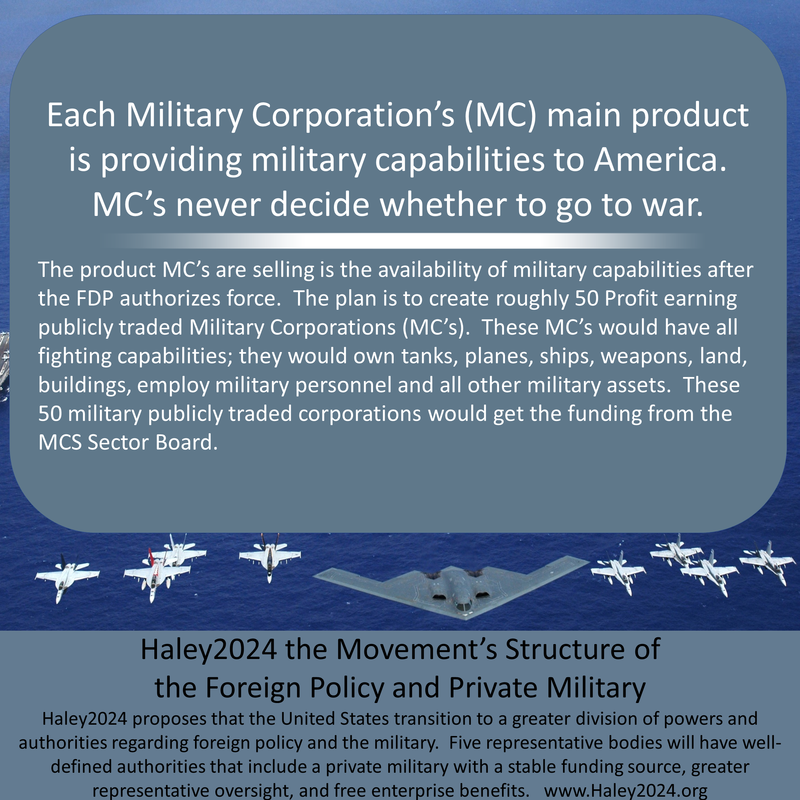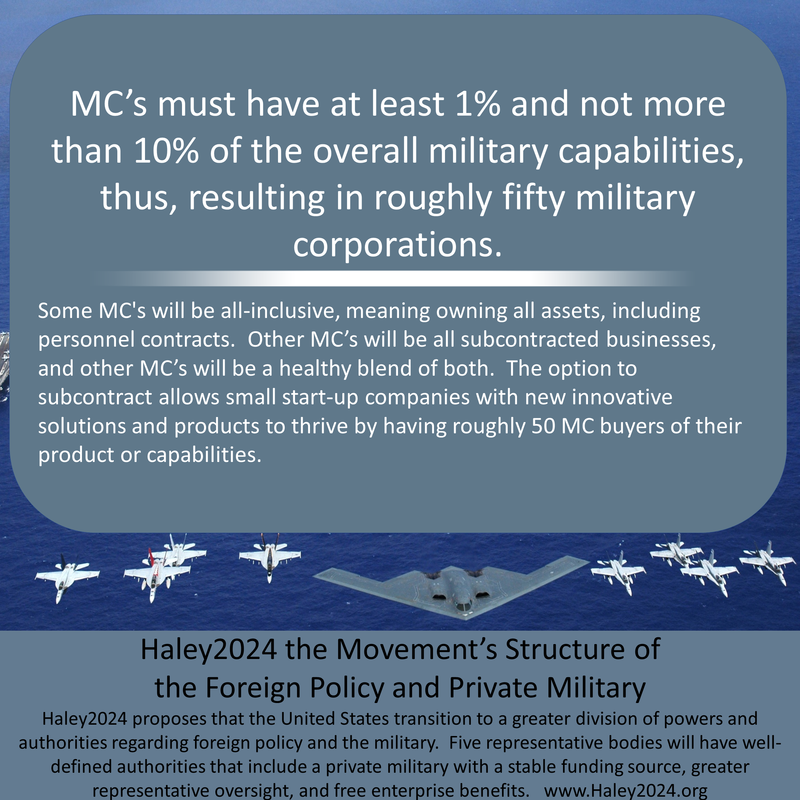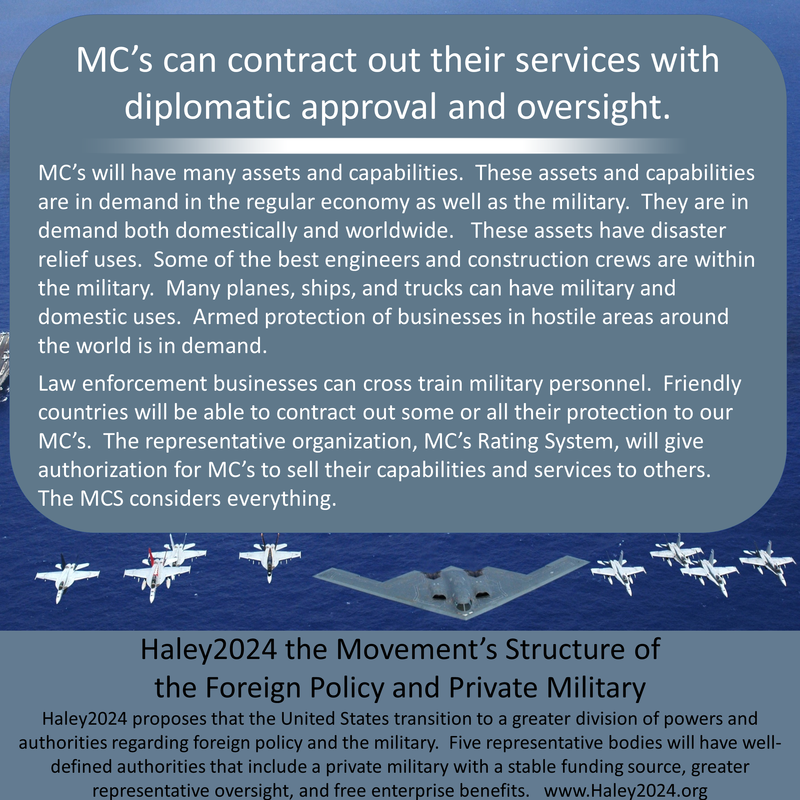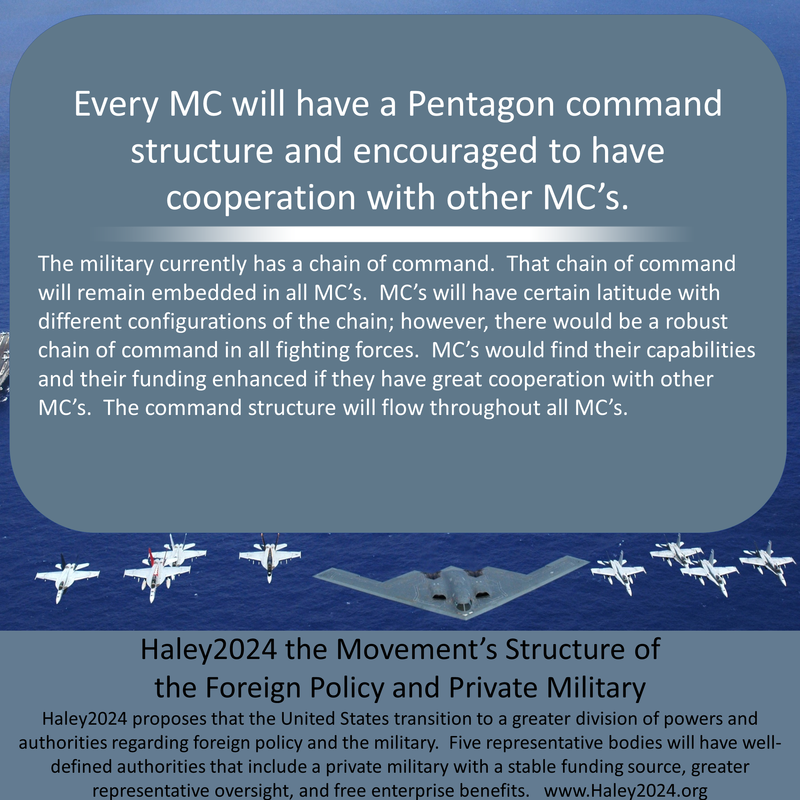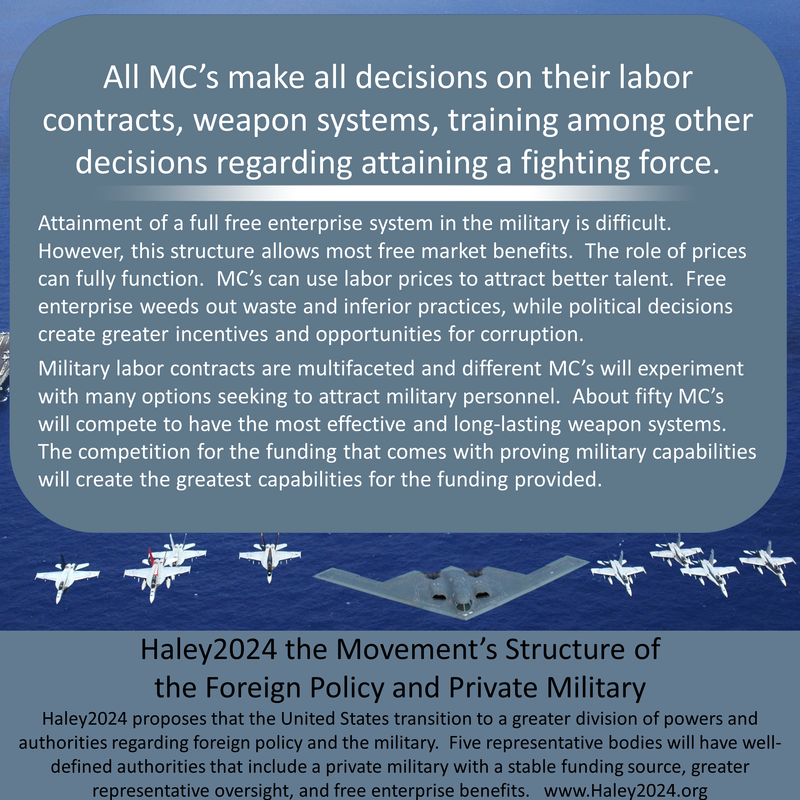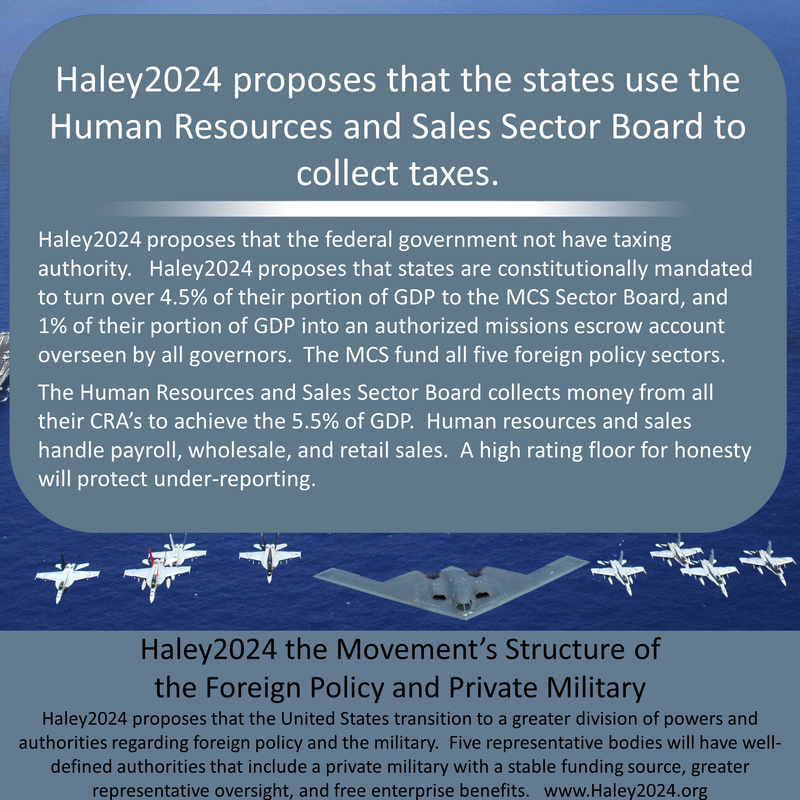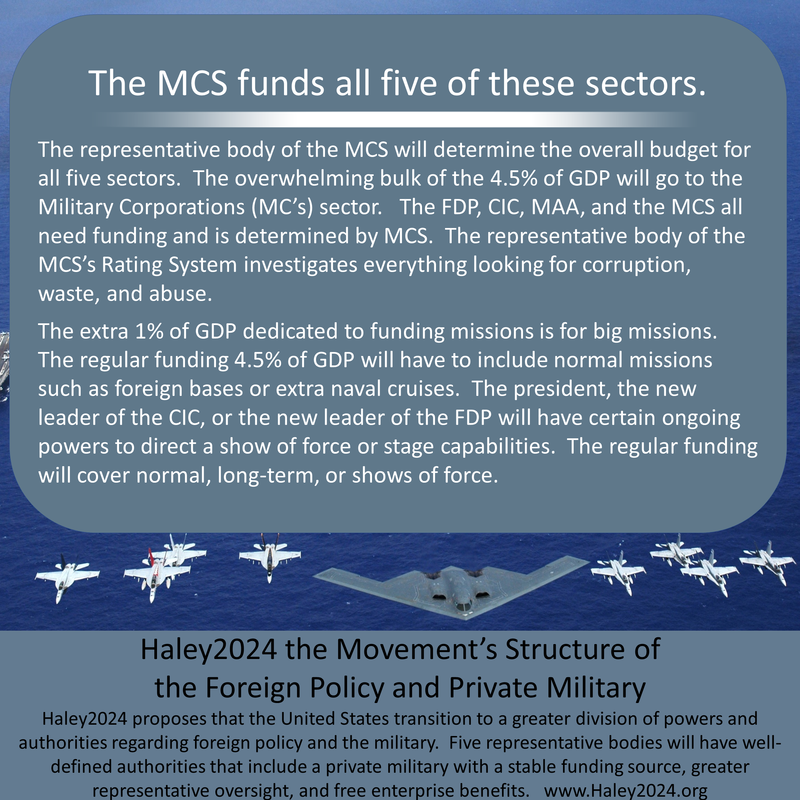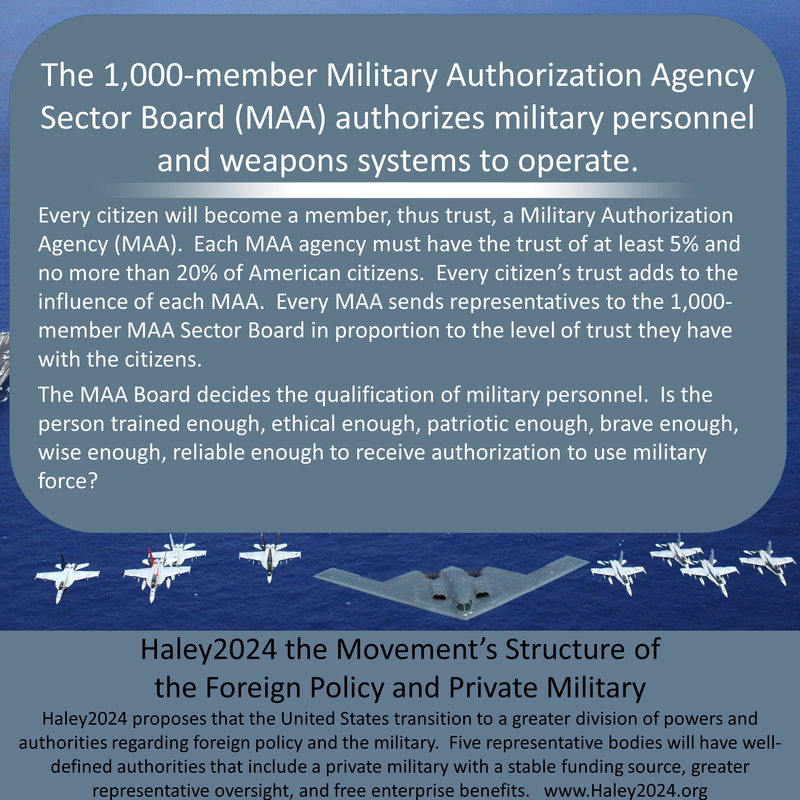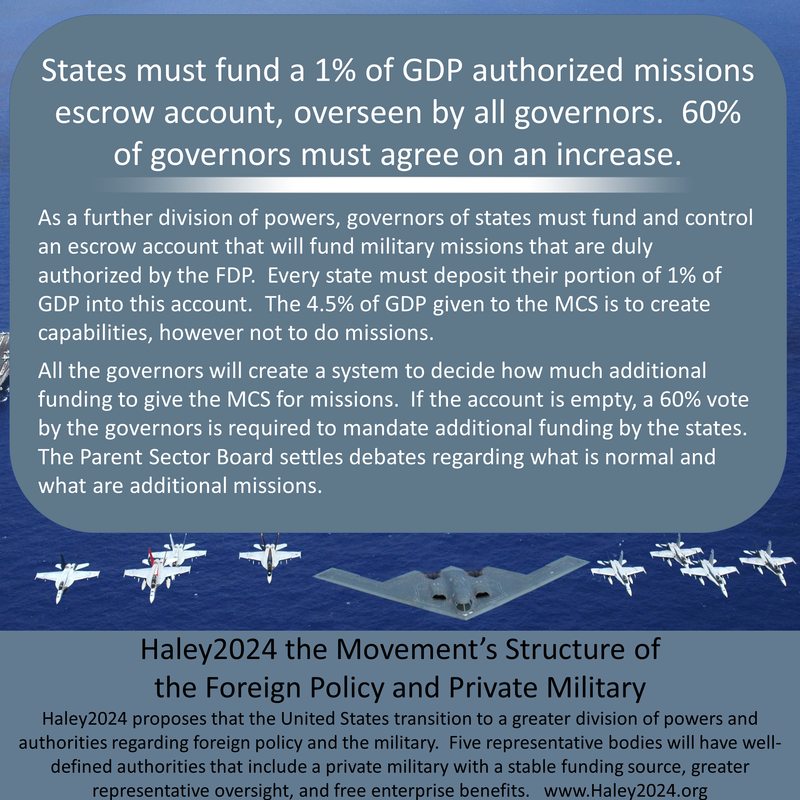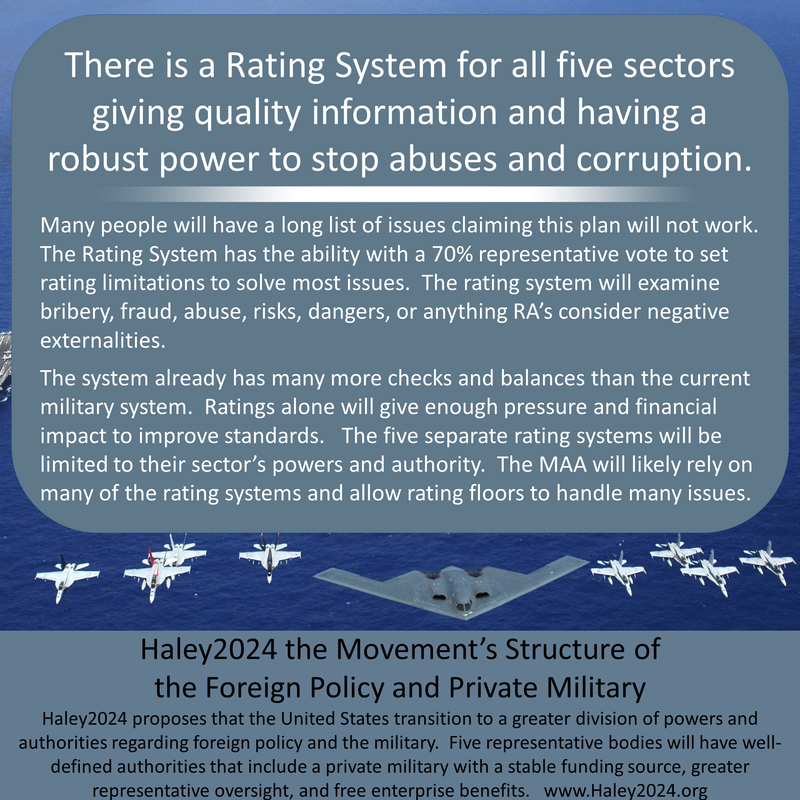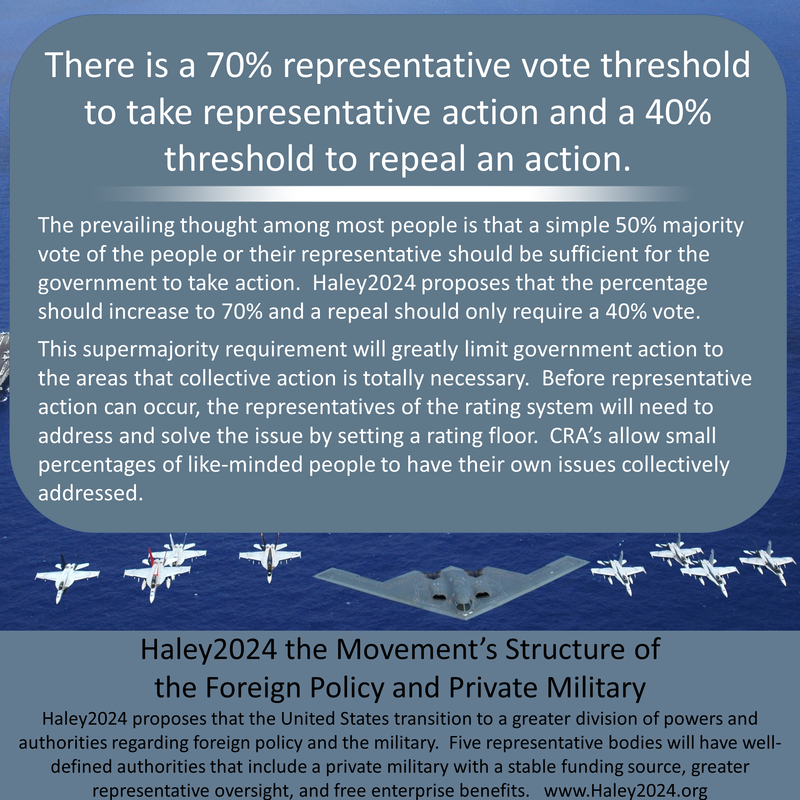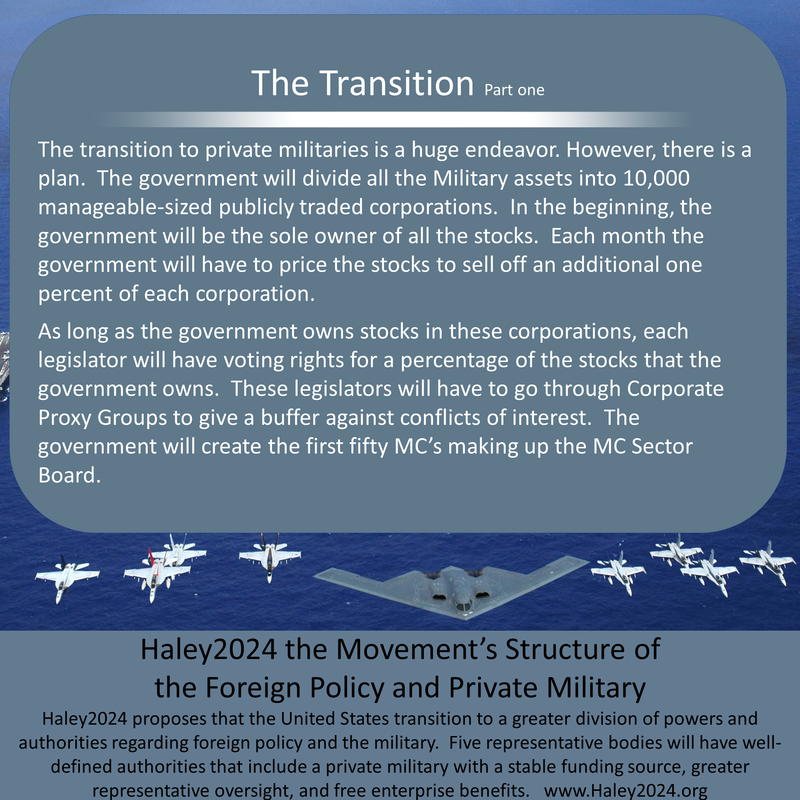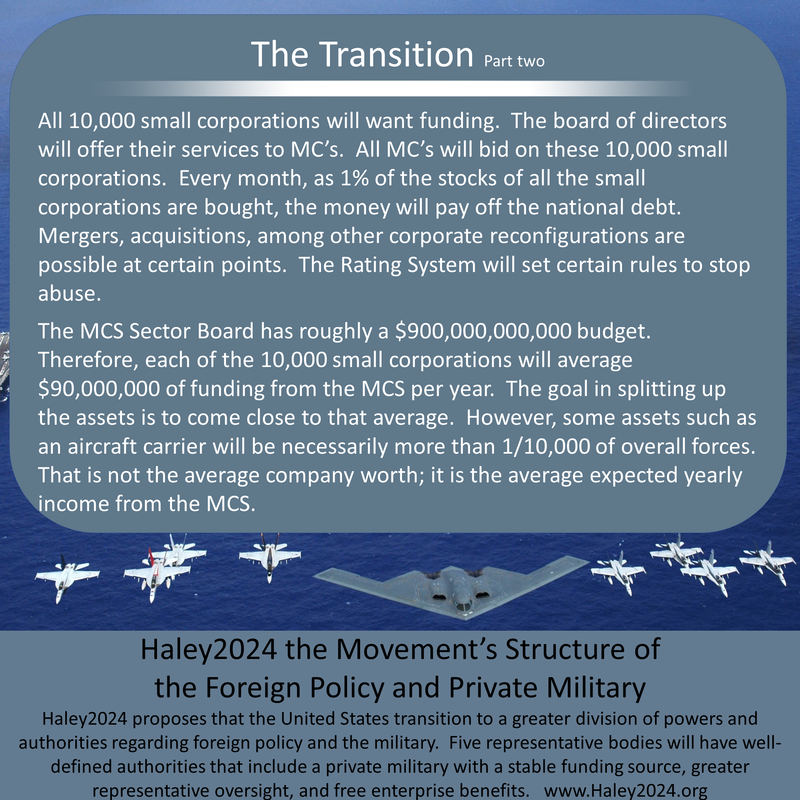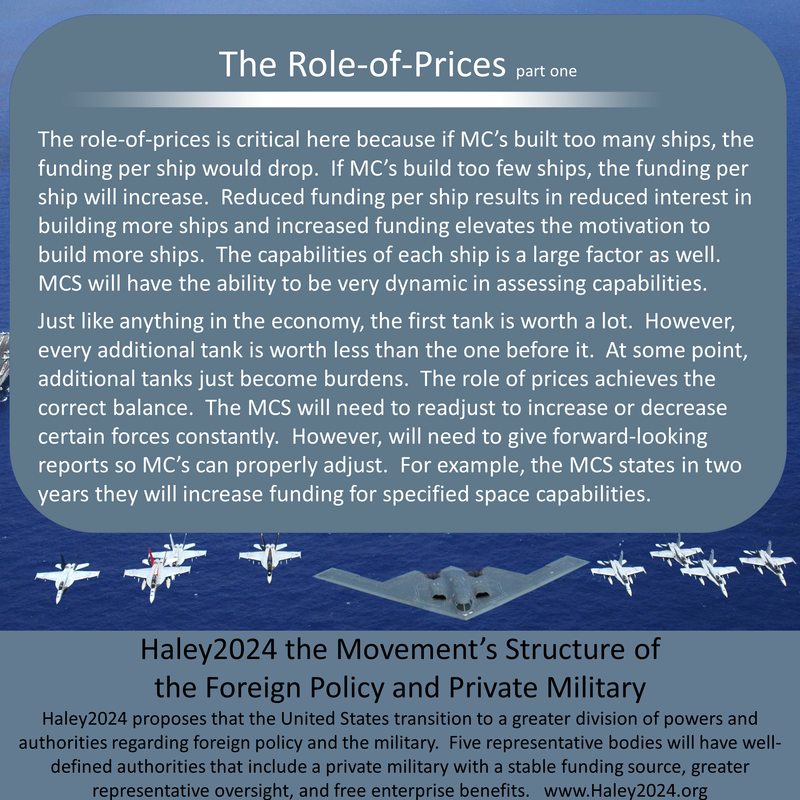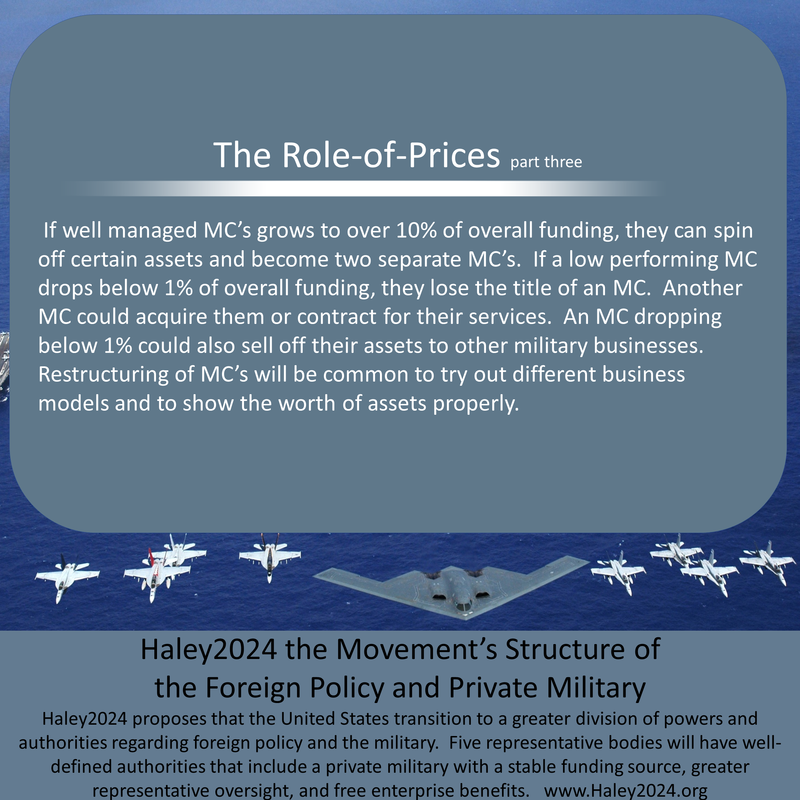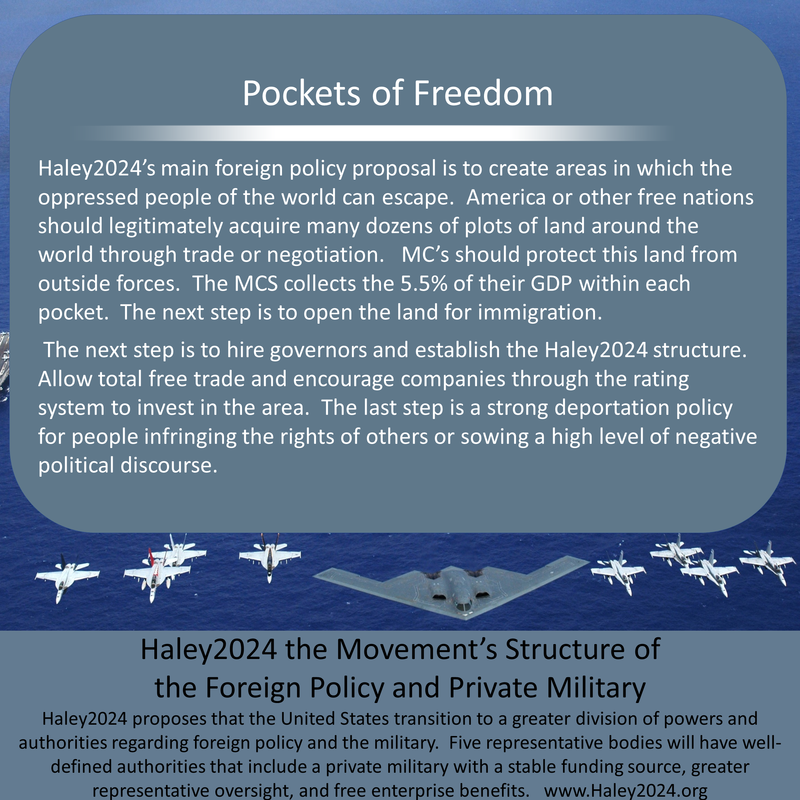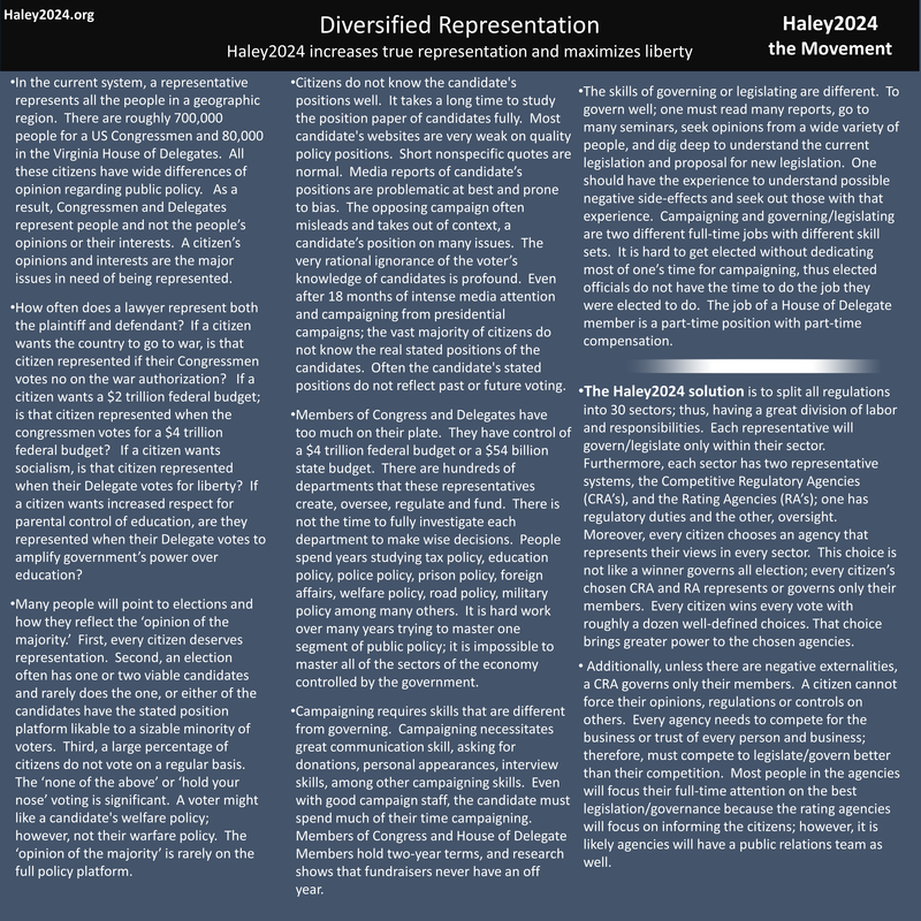Structure of the Foreign Policy and Private Military
The bullet points above were updated 9-12-2021. For any minor inconsistencies, please use the updated version above. It remains 98% consistent.
|
For thousands of years, governments, kings, dictators among other leaders and oppressors, never advanced living standards much until America tried a combination of liberty, freedom, rights, and a small limited government. Another key factor is a strong resolve of the people to protect their country militarily. A study of militaries throughout the history of the world shows the corruption of power of a strong military. America’s Constitution wisely established checks and balances by having a division of power. This division of power has given America better success and a lack of military overthrows; however, it is not immune.
The American people should always seek ways to divide authorities so no man nor a small group can use the military to overthrow America. The American people should not wait until things get out of control. The time to insert greater mitigating checks into the system is when the system is stable. Both the current socialized military and private military need to deal with the concerns of rogue units or even the full military, using military powers for their nefarious purposes. This Haley2024 structure establishes greater controls for these concerns. |
|
Haley2024 proposes that the United States have a division of responsibilities and authorities for foreign policy in five sectors.
The goal in reforming the military is to create additional divisions of authorities, greater accountabilities, and free enterprise benefits. Under Haley2024’s reforms, foreign affairs are the overwhelming focus of the Federal Government. Other Haley2024 reforms remove all other responsibilities from the Federal Government so that voters can concentrate their selections of governing agencies strictly on these issues. Representatives will have a much tighter concentration on their sets of responsibilities. Five sectors, with two representative bodies per sector, will allow voters and trusted leaders to concentrate their attention, responsibilities, and authorities.
|
|
Haley2024 proposes that representation switch from elections of individuals to selections of agencies
Most citizens do not have representation since their candidate did not win in the primary and the general election. Even when a citizen’s candidate wins, rarely do they share 100% of policy positions with the candidate. This new reform allows every citizen to select, thus become a member of a governing agency that closely matches their philosophy. Governing agencies are called Competitive Regulatory Agencies (CRA’s). Members select their CRA leaders and representatives. Every CRA sends representatives to CRA sector Boards in proportion to their membership. Everyone ‘wins’ their selection to their governing agency and the vote within the CRA’s will come from like-minded citizens. Every citizen has a much better sense of being represented.
|
|
The Foreign Diplomatic Policy (FDP) Sector sets immigration policy.
The FDP runs the state department and speaks for America on the world stage. The FDP sets immigration policy. The FDP must have a 70% vote to set citizenship standards. A 40% vote repeals those standards. Without an approved standard, nobody can become a citizen. Birthright citizen is always valid when at least one parent is a US citizen. The Identity businesses under the Identity sector controls identity and citizenship. The Identity sector rating system MUST set high standards regarding proof of citizenship.
The American people OWN this land and covet citizenship. Every citizen MUST meet their responsibilities of citizenship to remain a citizen. Every citizen has the choice to remain a citizen or give up the joint ownership of America. |
|
Every citizen picks an FDP agency that best represents their philosophy. Roughly a dozen FDP agencies send 200 representatives, proportional to their membership, to the FDP Sector Board. These 200 FDP representatives vote on the one leader, who is America’s highest negotiator with other nations.
Every citizen will become a member, thus trust, a Foreign Diplomatic Policy (FDP). Each diplomatic agency must have the trust of at least 5% and no more than 20% of American citizens. Every citizen’s trust adds to the influence of each FDP. Every FDP sends representatives to the 200-member FDP in proportion to the level of trust they have with the citizens.
|
|
The 200 FDP representatives make foreign law, foreign policy, immigration policy, declares war, and authorizes the use of military power.
These representatives will elect a leader to negotiate with other countries. These representatives will create foreign policy and immigration law. The credible threat of force, demands greater respect for diplomatic words. There is a 70% FDP representative vote threshold to take action and a 40% threshold to repeal an action such as the authorization of the use of force.
|
|
All 200 FDP have real roles such as ambassadors, envoys, among others; however always under the leadership of the one FDP leader.
All 200 representatives of the American citizens will have real roles in the state department. They will have complete access to all information and will concentrate all their efforts and time to learn foreign policy. All FDP representatives will vote for one leader and must follow that leader's direction and advance the leader’s objectives. Significant direction or objectives must have a 70% FDP vote.
|
|
The Commander in Chief (CIC) Sector executes the power authorized by the FDP.
The rules of engagement is a political decision. The limitations of enhanced interrogations need to be set by elected leaders. A declaration of war does not indicate that the military kills everyone and destroys all property. In War-War-Two, the atomic bombs were intentionally aimed at civilians to break the will of the enemy.
Thoughts on that subject have changed, and military personnel take on greater risk to spear non-combatants. The diplomatic representatives do not need bad or hostile policies to hamper relationships with allies. However, the CIC needs to achieve his goal. The leaders of the FDP and the CIC need to communicate to an appropriate balance, yet not result in a command-by-committee. |
|
Every citizen picks a CIC agency that best represents their philosophy. Roughly a dozen CIC agencies send 50 representatives, proportional to their membership, to the CIC Sector Board. These 50 CIC representatives vote on the one leader, who is America’s highest Commander in Chief.
Every citizen will become a member, thus trust, a commander-in-chief agency (CIC). Each CIC agency must have the trust of at least 5% and no more than 20% of American citizens. Every citizen’s trust adds to the influence of each CIC. Every CIC sends representatives to the 50-member CIC Sector Board in proportion to the level of trust they have with the citizens. These representatives will elect a leader to be the commander-in-chief.
|
|
The leader of the CIC will have full access to all MC’s military assets and personnel to fulfill the powers authorized by the FDP.
The lead commander-in-chief has authority to use the necessary force from the MC’s to accomplish the mission. The command structure built into all fighting forces takes over command and fulfills the mission. The authorization of force by the FDP authorizes the MCS to dip into the appropriate amount of funds from the mission budget. (described below)
There would be concerns regarding the negative effects of command-by-committee that might be erroneously perceived. The system has many checks-and-balances. However, leaders within the structure have well-defined roles and robust authority. |
|
The other 49 representatives of the CIC have real roles in the command structure; however, always under the leadership of the one CIC Leader.
The 49 other representatives will have total unfettered access to all information regarding the CIC sector. They will all have responsibilities within the command structure; however, with the ability to fully study the full military system. The three rating systems within the military structure must approve with an 80% (very high) ratings on all fifty members, regarding issues surrounding background checks such as honesty, patriotism, loyalty, among others.
|
|
The Military Authorization Agency (MAA) Sector Board MUST do a complete background check on all FDP and CIC representatives AND approve with an 80% MMA vote.
Only 5% of citizens are required to become an FDP-CRA or a CIC-CRA. There is a real risk there is at least that percentage of Americans that are hostile to America. Given that these two sectors have their power and authority at the sector board level and the FDP and CIC hold great power; it is prudent to have significant background requirements. Every representative will have unfettered access to ALL CIC and FDP information.
|
|
The FDP must protect their authorization with a Diplomatic Accountability for War Panel that declares an end to the authorization and monitors if the CIC is staying within the authorization.
When a war is declared or force authorized, the FDP’s must send thirteen representatives to create an accountability-for-war-panel. This panel has the authority and responsibility to determine the end to the authorization or stop the Commander-in-Chief (CIC) when the CIC uses military force outside the authorization. The CIC can force a vote of all FDP representatives within three days appealing the panel decision. A 50% FDP vote upholds the panel's decision. New or expanded authorization requires a 70% FDP vote.
|
|
All military capabilities are in roughly 50 Military Corporations. (MC’s)
These roughly 50 MC’s would receive all the funding. However, these MC’s can subcontract to companies with greater business organizational options. If an MC falls below the 1% threshold, they can subcontract with another MC, or they can start to sell off parts. Free enterprise will be in full effect with the role-of-prices giving ample benefits. In the effort to reduce monopolistic tactics; if MC’s grow larger than 10%, they must divide the company into two or more MC’s or sell off assets to another MC. Given the percentage range of 1-10, roughly 50 MC’s are likely.
|
|
Each Military Corporation’s (MC) main product is providing military capabilities to America. MC’s never decide whether to go to war.
The product MC’s are selling is the availability of military capabilities after the FDP authorizes force. The plan is to create roughly 50 Profit earning publicly traded Military Corporations (MC’s). These MC’s would have all fighting capabilities; they would own tanks, planes, ships, weapons, land, buildings, employ military personnel and all other military assets. These 50 military publicly traded corporations would get the funding from the MCS Sector Board.
|
|
MC’s must have at least 1% and not more than 10% of the overall military capabilities, thus, resulting in roughly fifty military corporations.
Some MC's will be all-inclusive, meaning owning all assets, including personnel contracts. Other MC’s will be all subcontracted businesses, and other MC’s will be a healthy blend of both. The option to subcontract allows small start-up companies with new innovative solutions and products to thrive by having roughly 50 MC buyers of their product or capabilities.
|
|
Every citizen will have opportunities to buy stocks in publicly traded Military Corporations (MC), thus voting rights for the board of directors of their MC.
A major check on abuse is forcing a company into a business model where people can freely buy stocks and have a vote on the board of directors. The Haley2024 reform of Corporate Proxy Groups will help alleviate the rational ignorance problem of stock-holders only having a small influence on corporate elections. For-profit companies paying a healthy return on investment brings in necessary capital to the business. Monetizing certain stable military assets can also create the capital necessary for new weapon systems.
|
|
MC’s can contract out their services with diplomatic approval and oversight.
MC’s will have many assets and capabilities. These assets and capabilities are in demand in the regular economy as well as the military. They are in demand both domestically and worldwide. These assets have disaster relief uses. Some of the best engineers and construction crews are within the military. Many planes, ships, and trucks can have military and domestic uses. Armed protection of businesses in hostile areas around the world is in demand.
Law enforcement businesses can cross train military personnel. Friendly countries will be able to contract out some or all their protection to our MC’s. The representative organization, MC’s Rating System, will give authorization for MC’s to sell their capabilities and services to others. The MCS considers everything. |
|
Every MC will have a Pentagon command structure and encouraged to have cooperation with other MC’s.
The military currently has a chain of command. That chain of command will remain embedded in all MC’s. MC’s will have certain latitude with different configurations of the chain; however, there would be a robust chain of command in all fighting forces. MC’s would find their capabilities and their funding enhanced if they have great cooperation with other MC’s. The command structure will flow throughout all MC’s.
|
|
All MC’s make all decisions on their labor contracts, weapon systems, training among other decisions regarding attaining a fighting force.
Attainment of a full free enterprise system in the military is difficult. However, this structure allows most free market benefits. The role of prices can fully function. MC’s can use labor prices to attract better talent. Free enterprise weeds out waste and inferior practices, while political decisions create greater incentives and opportunities for corruption.
Military labor contracts are multifaceted and different MC’s will experiment with many options seeking to attract military personnel. About fifty MC’s will compete to have the most effective and long-lasting weapon systems. The competition for the funding that comes with proving military capabilities will create the greatest capabilities for the funding provided. |
|
All states and territories must, by law, turn over 4.5% of their GDP to the Military Capabilities System (MCS) Sector Board.
The Parent Sector Board decides the percentage of GDP needed to defend America. 4.5% of GDP is the rough average over the decades. The governors of all the states and territories must, by law, fund the MCS sector directly. Funding in this manner is very stable over the years. MC’s will have a long-term reliance on overall funding.
The MCS could have continuous weekly reports announcing percentages. Required forward projections reports relating to coming weapon systems among others will create more reliable business models that yield more capabilities. |
|
Haley2024 proposes that the states use the Human Resources and Sales Sector Board to collect taxes.
Haley2024 proposes that the federal government not have taxing authority. Haley2024 proposes that states are constitutionally mandated to turn over 4.5% of their portion of GDP to the MCS Sector Board, and 1% of their portion of GDP into an authorized missions escrow account overseen by all governors. The MCS fund all five foreign policy sectors.
The Human Resources and Sales Sector Board collects money from all their CRA’s to achieve the 5.5% of GDP. Human resources and sales handle payroll, wholesale, and retail sales. A high rating floor for honesty will protect under-reporting. |
|
The 1,000-member Military Capabilities System (MCS) Sector Board funds Military Corporations (MC’s) based on their percentage of overall military capabilities.
Every citizen will become a member, thus trust, a Military Capabilities System Agency (MCS). Each MCS agency must have the trust of at least 5% and no more than 20% of American citizens. Every citizen’s trust adds to the influence of each MCS. Every MCS sends representatives to the 1,000-member MCS Sector Board in proportion to the level of trust they have with the citizens.
These MCS representatives create a system to maximize military capabilities in all the needed areas. The MCS will decide; however, it is likely they will assign percentages of funding towards air power, land forces, nuclear weapons, naval forces, among others. Crossover capabilities among other issues are concerns. The goal of the MCS is to have all areas properly covered consistently and reliably. |
|
The MCS funds all five of these sectors.
The representative body of the MCS will determine the overall budget for all five sectors. The overwhelming bulk of the 4.5% of GDP will go to the Military Corporations (MC’s) sector. The FDP, CIC, MAA, and the MCS all need funding and is determined by MCS. The representative body of the MCS’s Rating System investigates everything looking for corruption, waste, and abuse.
The extra 1% of GDP dedicated to funding missions is for big missions. The regular funding 4.5% of GDP will have to include normal missions such as foreign bases or extra naval cruises. The president, the new leader of the CIC, or the new leader of the FDP will have certain ongoing powers to direct a show of force or stage capabilities. The regular funding will cover normal, long-term, or shows of force. |
|
The 1,000-member Military Authorization Agency Sector Board (MAA) authorizes military personnel and weapons systems to operate.
Every citizen will become a member, thus trust, a Military Authorization Agency (MAA). Each MAA agency must have the trust of at least 5% and no more than 20% of American citizens. Every citizen’s trust adds to the influence of each MAA. Every MAA sends representatives to the 1,000-member MAA Sector Board in proportion to the level of trust they have with the citizens.
The MAA Board decides the qualification of military personnel. Is the person trained enough, ethical enough, patriotic enough, brave enough, wise enough, reliable enough to receive authorization to use military force? |
|
The Military Authorization Agency Sector Board (MAA) has strong authority to address abuse.
The 1,000 strong representative members of the MAA Board are vital to staffing a highly qualified and reliable military. The power to authorize also requires the power to strip that authorization when concerns reach a certain level. The large size of this board represents a strong commitment to addressing abuse.
It is a very serious violation of the law to operate military power without proper authorization from the MAA. If a soldier/unit abuses his/their authority or otherwise becomes untrustworthy, their authorization can be pulled and referred to the judicial authority. The MAA will have the authority to command authorized military forces to intervene when necessary. The MAA Board will set up a procedure to authorize weapon systems of significant concerns. |
|
All military personnel swears allegiance to America, the US Constitution, the FDP, the CIC, and the MAA with clear guidelines on the authorization of each representative body.
Swearing an allegiance is more robust when there is a love of country. The act of swearing allegiances educates military members about the limitations of all authorities and the appropriate action needed when authorities cross lines. The Military will train all officers within the chain of command of the limitations of all authorities and the proper response to every abuse and crossed line.
The diplomatic representatives declare war and set certain policies. The Commander-in-Chief commands forces to accomplish the approved mission. The MAA authorizes people to use weapons of war. |
|
States must fund a 1% of GDP authorized missions escrow account, overseen by all governors. 60% of governors must agree on an increase.
As a further division of powers, governors of states must fund and control an escrow account that will fund military missions that are duly authorized by the FDP. Every state must deposit their portion of 1% of GDP into this account. The 4.5% of GDP given to the MCS is to create capabilities, however not to do missions.
All the governors will create a system to decide how much additional funding to give the MCS for missions. If the account is empty, a 60% vote by the governors is required to mandate additional funding by the states. The Parent Sector Board settles debates regarding what is normal and what are additional missions. |
|
There is a Rating System for all five sectors giving quality information and having a robust power to stop abuses and corruption.
Many people will have a long list of issues claiming this plan will not work. The Rating System has the ability with a 70% representative vote to set rating limitations to solve most issues. The rating system will examine bribery, fraud, abuse, risks, dangers, or anything RA’s consider negative externalities.
The system already has many more checks and balances than the current military system. Ratings alone will give enough pressure and financial impact to improve standards. The five separate rating systems will be limited to their sector’s powers and authority. The MAA will likely rely on many of the rating systems and allow rating floors to handle many issues. |
|
The FDP, CIC, MCS, and MAA have almost all power at the sector board level. These are representative systems where every citizen selects an agency and agencies send representatives to their sector boards proportionate to their membership. The Military Corporation Sector keeps most power at MC and CRA level.
The very nature of the FDP, CIC, MCS, and MAA sectors requires most of the power at the representative sector board level. However, all representatives from all CRA’s will have unfettered access to all information and have real power in the structure of the sector. This real power is balanced with the need to speak with one voice. Representatives will choose their leaders, and all representatives will have to respect the direction. There will always be a balance between giving everyone their say and the dangers of leading by committee. Every representative body will have to find their balance.
The MC Sector should retain most of their power at the CRA or the MC levels. The MC Rating System will address issues with rating floors before the need to move up to representative sector board control. |
|
There is a 70% representative vote threshold to take representative action and a 40% threshold to repeal an action.
The prevailing thought among most people is that a simple 50% majority vote of the people or their representative should be sufficient for the government to take action. Haley2024 proposes that the percentage should increase to 70% and a repeal should only require a 40% vote.
This supermajority requirement will greatly limit government action to the areas that collective action is totally necessary. Before representative action can occur, the representatives of the rating system will need to address and solve the issue by setting a rating floor. CRA’s allow small percentages of like-minded people to have their own issues collectively addressed. |
|
The Transition Part one
The transition to private militaries is a huge endeavor. However, there is a plan. The government will divide all the Military assets into 10,000 manageable-sized publicly traded corporations. In the beginning, the government will be the sole owner of all the stocks. Each month the government will have to price the stocks to sell off an additional one percent of each corporation.
As long as the government owns stocks in these corporations, each legislator will have voting rights for a percentage of the stocks that the government owns. These legislators will have to go through Corporate Proxy Groups to give a buffer against conflicts of interest. The government will create the first fifty MC’s making up the MC Sector Board. |
|
The Transition Part two
All 10,000 small corporations will want funding. The board of directors will offer their services to MC’s. All MC’s will bid on these 10,000 small corporations. Every month, as 1% of the stocks of all the small corporations are bought, the money will pay off the national debt. Mergers, acquisitions, among other corporate reconfigurations are possible at certain points. The Rating System will set certain rules to stop abuse.
The MCS Sector Board has roughly a $900,000,000,000 budget. Therefore, each of the 10,000 small corporations will average $90,000,000 of funding from the MCS per year. The goal in splitting up the assets is to come close to that average. However, some assets such as an aircraft carrier will be necessarily more than 1/10,000 of overall forces. That is not the average company worth; it is the average expected yearly income from the MCS. |
|
The Role-of-Prices part one
The role-of-prices is critical here because if MC’s built too many ships, the funding per ship would drop. If MC’s build too few ships, the funding per ship will increase. Reduced funding per ship results in reduced interest in building more ships and increased funding elevates the motivation to build more ships. The capabilities of each ship is a large factor as well. MCS will have the ability to be very dynamic in assessing capabilities.
Just like anything in the economy, the first tank is worth a lot. However, every additional tank is worth less than the one before it. At some point, additional tanks just become burdens. The role of prices achieves the correct balance. The MCS will need to readjust to increase or decrease certain forces constantly. However, will need to give forward-looking reports so MC’s can properly adjust. For example, the MCS states in two years they will increase funding for specified space capabilities. |
|
The Role-of-Prices part two
This new system is a basic incentive structure. There is a pot of money, and roughly 50 MC’s are competing for a greater share of it. As an example, let's say the MCS has $100x to distribute. If one of the Military Corporations (MC’s) has a carrier battle group, tanks, satellites, 130,000 men and 1,000 planes, they might be rated to have 6.26894% of total military capabilities. This MC would get $6.26894x to fund their operations.
If the amount is $900 billion a year, then that 6.26894% worth of capabilities is funded with $56,420,460,000. It is likely the system will be a daily payout with a three-month lead time so proper planning can take place. An MC will only have increased funding to demand increased military labor hours if they are doing a better job than their competitors. |
|
The Role-of-Prices part three
If well managed MC’s grows to over 10% of overall funding, they can spin off certain assets and become two separate MC’s. If a low performing MC drops below 1% of overall funding, they lose the title of an MC. Another MC could acquire them or contract for their services. An MC dropping below 1% could also sell off their assets to other military businesses. Restructuring of MC’s will be common to try out different business models and to show the worth of assets properly.
|
|
The Economic Benefits of Patriotism
The best way to have a trusted military free from corruption and overthrows is a high level of patriotism. A good government that protects liberties, freedoms, and rights enhances patriotism. Military members need to love their country and believe their service, and possible sacrifice is worth the fight. There are great economic benefits when people are willing to fight for their loved ones to be free and not just to be paid. High levels of patriotism help people resist an offer to switch sides.
|
|
Pockets of Freedom
Haley2024’s main foreign policy proposal is to create areas in which the oppressed people of the world can escape. America or other free nations should legitimately acquire many dozens of plots of land around the world through trade or negotiation. MC’s should protect this land from outside forces. The MCS collects the 5.5% of their GDP within each pocket. The next step is to open the land for immigration.
The next step is to hire governors and establish the Haley2024 structure. Allow total free trade and encourage companies through the rating system to invest in the area. The last step is a strong deportation policy for people infringing the rights of others or sowing a high level of negative political discourse. |

